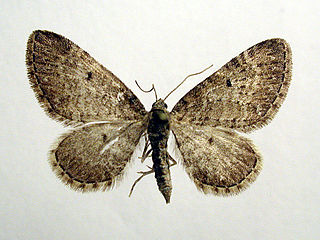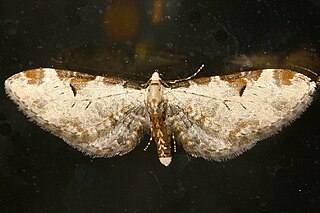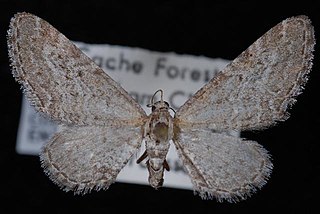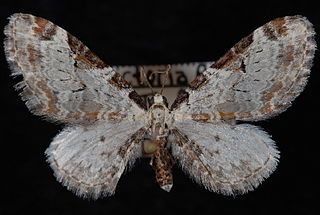
Eupithecia satyrata, the satyr pug, is a species of moth of the family Geometridae. It was described by Jacob Hübner in 1813. It is found from Ireland, through northern and central Europe east to all of Russia and central Asia and western Siberia to Tibet. It is also present in North Africa and North America.
Eupithecia catalinata is a moth in the family Geometridae first described by James Halliday McDunnough in 1944. It is found in the southern United States, including Utah, Arizona and New Mexico.

Eupithecia borealis is a moth in the family Geometridae first described by George Duryea Hulst in 1898. It is found in North America, including Alberta, Arizona, British Columbia, California, Colorado, Manitoba, Michigan, Montana, New Brunswick, New Mexico, New York, Newfoundland and Labrador, Nova Scotia, Ontario, Quebec, Utah and Wyoming.
Eupithecia herefordaria, or Hereford's eupithecia, is a moth in the family Geometridae. It is found in south-eastern Arizona, United States.

Eupithecia cimicifugata is a moth in the family Geometridae first described by Pearsall in 1908. It is found in North America, including Alberta, Ontario, Saskatchewan, Kentucky, Maryland and South Dakota.
Eupithecia nimbosa is a moth in the family Geometridae first described by George Duryea Hulst in 1896. It is widespread in the Rocky Mountains, from Arizona to the Canada–US border.
Eupithecia flavigutta is a moth in the family Geometridae first described by George Duryea Hulst in 1896. It is found in the United States in Colorado and montane forest areas in eastern Arizona and south-western New Mexico.

Eupithecia nevadata is a moth in the family Geometridae first described by Alpheus Spring Packard in 1871. It is found in western North America.
Eupithecia slossonata is a moth in the family Geometridae first described by James Halliday McDunnough in 1949. It is found in the US states of Florida, Georgia, Kentucky and Maryland.
Eupithecia sabulosata is a moth in the family Geometridae first described by James Halliday McDunnough in 1944. It is found in the US state of California.

Eupithecia misturata is a moth in the family Geometridae first described by George Duryea Hulst in 1896. It is widely distributed in western North America.
Eupithecia sheppardata is a moth in the family Geometridae first described by James Halliday McDunnough in 1938. It is found in North America, including New Brunswick, Ontario, Quebec, Maine and New York.
Eupithecia quakerata is a moth in the family Geometridae first described by Pearsall in 1909. It is found in the US states of Colorado, Utah, New Mexico, Arizona and California.
Eupithecia biedermanata is a moth in the family Geometridae first described by Samuel E. Cassino and Louis W. Swett in 1922. It is found in the US state of Arizona.

Eupithecia russeliata is a moth in the family Geometridae first described by Louis W. Swett in 1908. It is widespread in North America, including Alberta, California, Kentucky, Maine, Maryland, Minnesota, New Brunswick, Newfoundland and Labrador, North Carolina and Nova Scotia.

Eupithecia zygadeniata is a species of moth in the family Geometridae. It was first described by Alpheus Spring Packard in 1876 and is found in North America, with records from Texas and Montana. Adults have been recorded on wing in June and July.

Eupithecia behrensata is a moth in the family Geometridae first described by Alpheus Spring Packard in 1876. It is found in North America from California north to British Columbia, Alberta and Saskatchewan.

Eupithecia olivacea is a moth in the family Geometridae first described by Taylor in 1906. It is found in North America from British Columbia south through Washington and Oregon to California.
Eupithecia plumasata is a moth in the family Geometridae first described by James Halliday McDunnough in 1946. It is found in the US state of California.

Eupithecia ravocostaliata, commonly known as the tawny eupithecia or great variegated pug, is a species of moth in the family Geometridae. The species was first described by Alpheus Spring Packard in 1876. It is found in northern New York and the New England states, extending across Canada from the Maritime provinces to Vancouver Island and down the west coast as far as the San Francisco Bay region.










